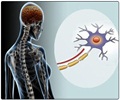The gut bacteria differ in multiple sclerosis patients and healthy people. It also varies in patients receiving different treatments.
- There are differences between the gut bacteria of people with multiple sclerosis and those who are healthy
- Gut microbiome also varies between MS patients who are undergoing various medication regimens
Advances in DNA sequencing in the early 2010s gave researchers a clearer image of the bacteria found in the stool, blood, mucosal tissue and skin samples. It has greatly expanded the area of microbiome studies.
Connection Between Gut Flora and Multiple Sclerosis
Until recently, studies in mice have provided most of the experimental data pointing to a connection between gut flora and MS. Studies on humans had produced erratic results, in part due to limited participant populations and an inability to account for how the environment affects the microbiome. The bacteria in our bodies greatly depend on where we live- whether in the city or the countryside, adjacent to an oil refinery or on a mountain top.“This is the reference study that will be used by the field for years to come,” said Sergio Baranzini, PhD, the Heidrich Family and Friends Endowed Chair in Neurology and member of the UCSF Weill Institute for Neurosciences, who is the lead author on the new study.
With their innovative protocol, Baranzini and his colleagues identified dozens of new bacteria species associated with MS and confirm other species that had previously only been associated with the disease. “We were surprised by the number of species that were differentially present in MS when compared to controls,” said Baranzini.
Reasons for Variation in Gut Microbiome
They also found that the largest source of variation in bacteria species was linked to the geographical location of the participants. It confirmed the importance of location and local variations in diet to the gut microbiome. The second largest source of variation was a participant’s disease status, which is what the researchers had expected.The study was the second in a series conducted by iMSMS, an international consortium established in 2015 for the purpose of determining the role of gut bacteria in MS disease susceptibility, progression and response to therapy. The first study validated the household control protocol, showing that it increases statistical power in population-based microbiome studies.
Gut Microbiota Differences Between Healthy People and Multiple Sclerosis Patients
The findings of the study are primarily descriptive, acknowledges Baranzini. “When looking at the microbiome, there are two questions that usually are asked,” he said. “The first one is ‘Who’s there?’ This is what we are trying to answer in this paper. The second is, ‘What are they doing?’”Answering the second question requires mechanistic studies with individual bacteria to understand their metabolic profiles. Still, the researchers got some hints at what the bacteria they found are doing by studying the potential pathways that these bacteria encode.
“Knowing which genes from which species we are able to identify in cases and controls, we can now start to reconstruct which potential pathways are active in patients and controls,” said Baranzini.
For example, some of the bacteria the team found to be associated with MS seem to play a role in helping humans process fibre from plants, the byproducts of which tend to be found in increased concentrations in MS patients. Other species seem to have an influence on inflammation and the energy production machinery of the cell.
Gut Microbiota in Patients Receiving Different Multiple Sclerosis Treatment
The researchers also found that patients treated with an immunomodulator known as interferon beta-1a, the oldest therapy for MS, have lower concentrations of short-chain fatty acids in their faeces and higher concentrations in their blood. Short-chain fatty acids are known for their anti-inflammatory properties, so this suggests that interferon works by increasing the transportation of these molecules from the gut to the bloodstream, which Baranzini said could be one of the mechanisms of action of interferon.The International Multiple Sclerosis Microbiome Study (IMSMS) collaboration of scientists recruited a sizable number of MS patients from three continents and selected genetically unrelated controls from the same homes as the patients to get around these restrictions. This methodology had never been applied to such a sizable investigation. The study compares the gut microbiota patterns of 576 patients and an equivalent number of household controls in the US, the UK, Spain, and Argentina. It was published in Cell. The research could result in brand-new treatments that entail dietary changes or microbiota manipulation.
Novel Bacterial Species Linked with Multiple Sclerosis
With their ground-breaking technique, Baranzini and his associates confirmed numerous previously suspected bacterium species and found dozens of novel species linked to MS. “When compared to controls, we were shocked by the number of species that were differentially prevalent in MS,” stated Baranzini. Additionally, they discovered that the participants' geographic location was the main contributor to the variance in bacteria species, supporting the significance of geography and regional dietary variations for the gut microbiome. The researchers had anticipated that a participant's disease condition would be the second biggest cause of variation.Additionally, the short-chain fatty acid concentrations in the faeces of MS patients treated with interferon beta-1a, the oldest treatment for MS, were shown to be lower than those in the blood. This shows that interferon functions by enhancing the transfer of these molecules from the gut to the bloodstream, which Baranzini suggested could be one of the modes of action of interferon. Short-chain fatty acids are renowned for their anti-inflammatory characteristics.
Until the cohort reaches 2000 members, the iMSMS group will continue to recruit patients, expanding to Germany and Canada. Beginning this fall, they will also monitor a subset of patients for a period of two years to observe how their gut flora adjusts in response to therapy, lifestyle modifications, and the development of the illness. All the study’s data will be accessible to the public.
“This is an example of how big science can only be achieved collaboratively,” he added. “In the iMSMS, we really brought together the best and the brightest researchers in the microbiome research field and in multiple sclerosis, and they are all pulling towards the same objective.”
Source-Medindia
















